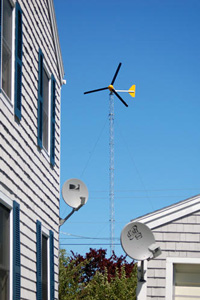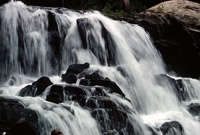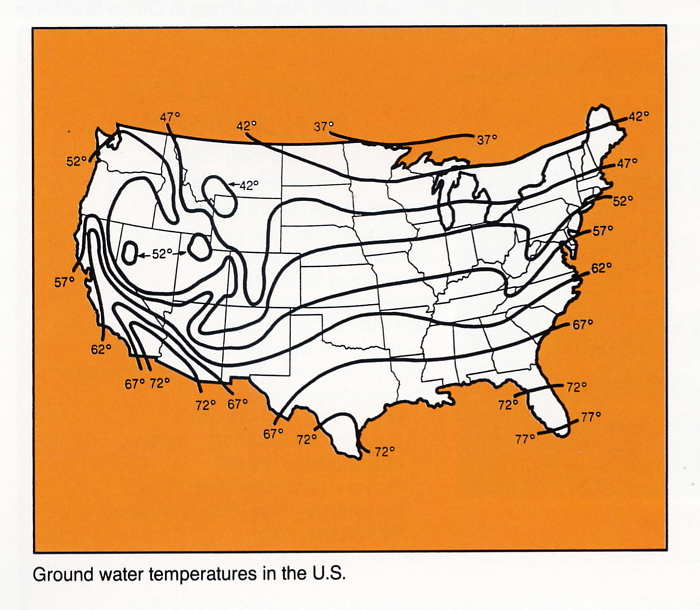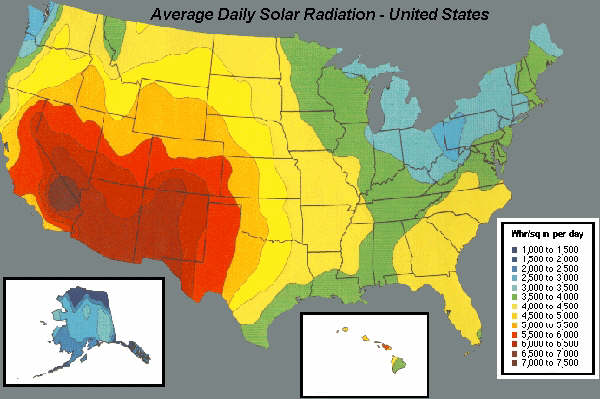Why after 40 years in the solar and geothermal business why did we stop doing solar? Time! We did solar pool heating, domestic hot water, and photo-voltaics but stopped all of that to focus on geothermal only. The average building or homeowner spends from 60 – 70% of their energy costs on heating and cooling. That’s why!
With geothermal you get “the biggest bang for your buck”. Other renewable technologies only address a small percentage of the average person’s energy cost. Solar P/V is 5-10%, Solar DHW is 20%, Geothermal HVAC is 60-70%. We know, we have done all of these.
We do believe in and support other renewable energy technologies including Solar, Wind, Hydro Electric, and Wood. We just don’t have time for anything but geothermal!




Regional Renewable Energy ( Solar & Ground Water Maps Attachment )
Common Sense –
Use your head. You can only use what renewable energy is available in your area. If you have lived there for over one full year you should have a pretty good idea what that would be. So don’t even consider those technologies that are not in your area, and would not be able to aid you in reducing your carbon footprint and/or energy consumption.
With today’s state-of-the-art geothermal equipment 72 – 75% of heating and cooling energy can come from the earth, responsibly.
Please look at our web site in depth, as there is over 35 years of data there, including a booklet we published in the 1980’s to regionalize ideas that were published in national magazines, most of which only pertained to the Southwest.
When you pick up a national or world publication for articles or ideas about sources of geo- thermal energy for space heating or cooling you get the whole gamut of possibilities world wide.
When you think regionally some of those ideas may not work in your particular case. Examples would be as follows:
Southwest – Solar energy is abundant, as can be seen by the attached solar radiation map.
The earth is relatively hot in those same areas. According to the National Ground Water Association (NGWA) , between 70 and 75’F. In the peak of those Summers the air temper- ature can be over 100’F, regularly. For the best economics combine a geothermal cooling system with a Photo-Voltaic / Electric system to produce some, or most of your needed electricity during those times. This area requires much more cooling than heating. When choosing equipment look for the highest EER, best cooling output, and dehumidification ratings. Heating is only a secondary concern, as it is seldom needed.
What works – horizontal or slinky wound loops – frost goes down inches, not feet – easier to trench than drill in red clay. Also Pond or Lake loops can work here. Solar Photo-Voltaic Systems give the best performance here.
What doesn’t – Open Loops or VSWC, as the same red clay will plate up everything it contacts due to it’s “mud in suspension” consistency.
Central States – Solar energy is less abundant, as can be seen by the attached solar radiation map. The earth is not as hot in those areas. According to the National Ground Water Association (NGWA), in the mid 60’s ‘F. Summers seldom reach 100’F, staying in the 80’s and 90’s. Winters are also less severe than the North with temperatures in the 20’s and 30’s common. For the best economics combine a geothermal Heating & Cooling system with a Wind Powered / Electric system to produce some, or most of your needed electricity during those times. This area often has an equal balance of Cooling and Heating loads. When choosing equipment look for the best balance of good COP for heating and EER for cooling. What we are saying is that both Cooling and Heating are of concern, and they are of about equal significance.
What works – Still your best performance option is the Open Loop or VSWC if there is not significant amounts of colloidal clay in the water. If so, a closed loop may still have to be your only option. Even then, you can use either water in the loops or non-toxic proylene-glycol as your antifreeze as the heating run times should not cause it to slush-up as it would in the North. Pond or lake loops can work in some climates. Solar Photo-Voltaic systems give average performance here.
What doesn’t – Open Loops or VSWC if the red clay will plate on everything it contacts. You will have to accept the 25-30% performance downgrade from transferring heat twice, through the walls of a poly-plastic pipe.
Northeast – Solar energy is the lowest in the USA, as can be seen by the attached solar radiation map. The earth is relatively cool in those same areas. According to the National Ground Water Association (NGWA) , between 48 and 52’F. In the peak of those Winters the air temperature can be under -30-F. Summers rarely exceed 90’F, and even that, for relatively short periods of time. For the best economics combine a geothermal Heating and Cooling system with a Wind Powered / Electric system, where available, to produce some, or most of your needed electricity during those times. This area requires much more heating than cooling. When choosing equipment look for the highest COP and Heating Output. Cooling performance is only of secondary concern.
What works – Open Loops of VSWC provide the best economics of operation. Over 25-30% higher than vertical closed loops.
What doesn’t – Closed loops in this region will require the use of METHANOL, or some other toxic anti-freeze as the long run times in Winter would slush-up the non-toxic propylene-glycol preferred in the Southwest of Central States. Obviously horizontal, pond and lake loops are out of the question. You can’t get heat from a frozen body of water. The earth is the heat source. The water we bring up from the Open Loop / VSWC well is earth heated water.The well water is only the heat transfer medium. Solar Photo-Voltaic Systems give significantly less performance than the rest of the USA.
Obviously cost of installation is a major concern to most home and building owners. In the North, since shallow ( 3- 8 ft.) horizontal trenches are out of the question, vertical systems are the only choice. In areas where there is high density bedrock near the surface the drilling cost for VSWC systems is much less, as wells only have to be cased to bedrock and heat transfer in the VSWC column is equal for the steel casing or high density bedrock. However, in areas where there is a lot of overburden ( the unconsolidated earth, stone, gravel, etc. ) above the bedrock and continues down for many hundreds of feet, can be cost prohibitive. Today’s rate for casing is $20+ per foot of 6 ” steel casing. For obvious reasons PVC plastic casing would not be recommended for VSWC applications.
So, use your Common Sense, Think ! –
Recently we have seen a re-growth in the solar industry in the Northeast. Though we truly believe in all types of renewable energy we have tested the three solar options and found you can’t get what isn’t there. Look at the attached Solar Radiation Map for the continental USA. Obviously the best option for renewable energy in the Southwest is Solar. Not so for the Northwest and our Northeast. So, after over 3 decades of doing solar installations for Domestic Hot Water or Photo-Voltaic to Electricity Conversions or Swimming Pool Heating we stopped.
For our part of the country Geothermal is what will save the most energy and money. All others are minor when compared to the energy consumed for Heating & Cooling.
| Average % of energy consumption of most households: | ||
| Electricity | 5 – 10% | |
| Domestic Hot Water | 15 – 20% | |
| Heating and Cooling | 60 – 70 % | |
Through our over 40 years of experience in the renewable energy field we have found out what works best, and gives the most reasonable investment. Those new to the industry, who have just jumped onto the “green bandwagon” don’t know what works and most importantly, what doesn’t, yet. You don’t have money to waste being part of their learning curve.
As part of the stimulus package there is a federal tax credit on geothermal residential installations, both new construction and retrofit, that meet both AHRI and Energy Star Guidelines. This is a tax credit is 30% of the total cost of an installation, with no limit (through 12/31/2016). Since the guidelines are focused on the highest efficiency, only those units that deliver warm and cool air are eligible, as this is the most efficient way to deliver geothermal energy.
In a nutshell, Common Sense proves why we can’t heat our homes with solar energy, because it isn’t there when we need it most. Which is why we have Winter !!



